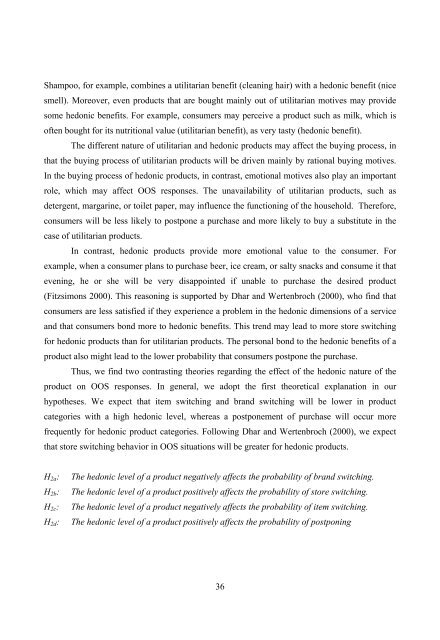Understanding Consumer Reactions to Assortment Unavailability
Understanding Consumer Reactions to Assortment Unavailability
Understanding Consumer Reactions to Assortment Unavailability
Create successful ePaper yourself
Turn your PDF publications into a flip-book with our unique Google optimized e-Paper software.
Shampoo, for example, combines a utilitarian benefit (cleaning hair) with a hedonic benefit (nice<br />
smell). Moreover, even products that are bought mainly out of utilitarian motives may provide<br />
some hedonic benefits. For example, consumers may perceive a product such as milk, which is<br />
often bought for its nutritional value (utilitarian benefit), as very tasty (hedonic benefit).<br />
The different nature of utilitarian and hedonic products may affect the buying process, in<br />
that the buying process of utilitarian products will be driven mainly by rational buying motives.<br />
In the buying process of hedonic products, in contrast, emotional motives also play an important<br />
role, which may affect OOS responses. The unavailability of utilitarian products, such as<br />
detergent, margarine, or <strong>to</strong>ilet paper, may influence the functioning of the household. Therefore,<br />
consumers will be less likely <strong>to</strong> postpone a purchase and more likely <strong>to</strong> buy a substitute in the<br />
case of utilitarian products.<br />
In contrast, hedonic products provide more emotional value <strong>to</strong> the consumer. For<br />
example, when a consumer plans <strong>to</strong> purchase beer, ice cream, or salty snacks and consume it that<br />
evening, he or she will be very disappointed if unable <strong>to</strong> purchase the desired product<br />
(Fitzsimons 2000). This reasoning is supported by Dhar and Wertenbroch (2000), who find that<br />
consumers are less satisfied if they experience a problem in the hedonic dimensions of a service<br />
and that consumers bond more <strong>to</strong> hedonic benefits. This trend may lead <strong>to</strong> more s<strong>to</strong>re switching<br />
for hedonic products than for utilitarian products. The personal bond <strong>to</strong> the hedonic benefits of a<br />
product also might lead <strong>to</strong> the lower probability that consumers postpone the purchase.<br />
Thus, we find two contrasting theories regarding the effect of the hedonic nature of the<br />
product on OOS responses. In general, we adopt the first theoretical explanation in our<br />
hypotheses. We expect that item switching and brand switching will be lower in product<br />
categories with a high hedonic level, whereas a postponement of purchase will occur more<br />
frequently for hedonic product categories. Following Dhar and Wertenbroch (2000), we expect<br />
that s<strong>to</strong>re switching behavior in OOS situations will be greater for hedonic products.<br />
H2a: The hedonic level of a product negatively affects the probability of brand switching.<br />
H2b: The hedonic level of a product positively affects the probability of s<strong>to</strong>re switching.<br />
H2c: The hedonic level of a product negatively affects the probability of item switching.<br />
H2d: The hedonic level of a product positively affects the probability of postponing<br />
36

















